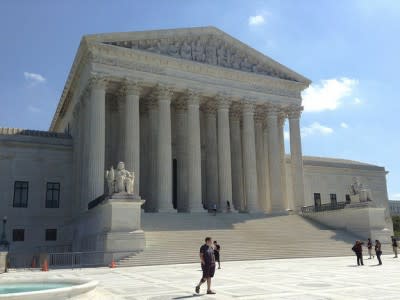Update: Supreme Court issues final three decisions on Monday
After a week of historic drama, the Supreme Court concluded its term on Monday with decisions about election districts, the environment and the death penalty.
Many observers thought the 2014 term was destined to end with major decisions about Obamacare and same-sex marriage. Instead, the Court released those decisions last Thursday and Friday. It also announced on Friday that Monday, June 29, was its last day.
The three remaining cases dealt with three unrelated subjects.
In Arizona State Legislature v. Arizona Independent Redistricting Commission (heard March 2, 2015), there were two questions in front of the Justices. One was if the Elections Clause of the Constitution and federal law allowed Arizona’s use of a commission to adopt congressional districts; the other was if the Arizona Legislature had standing to bring this suit to begin with.
In a 5-4 opinion written by Justice Ruth Bader Ginsburg, the majority said that Arizona legislature had standing to sue. But the Elections Clause and the federal statute allow Arizona to use a commission to draft federal congressional districts. Justice Anthony Kennedy was part of the majority.
Proposition 106, which was passed in 2000 by 56 percent of Arizona voters, established a statewide, bipartisan committee to oversee the redistricting process for state and congressional seats. But partisan fighting had affected the committee’s decisions. The GOP-controlled state legislature was hoping the Supreme Court would return control to Phoenix. But Monday’s ruling in favor of the bipartisan committee could have far-reaching effects about redistricting.
In Glossip v. Gross (heard April 29, 2015), the lawsuit was brought by several death-row inmates in Oklahoma. They claimed that the use of midazolam, an anti-anxiety medication, as a sedative during lethal injection violated a prisoner’s Eighth Amendment right to be free from cruel and unusual punishment.
In another 5-4 opinion, Justice Samuel Alito wrote for the majority and said that the death-row inmates failed to establish a likelihood of success on the merits on their claim that the use of midazolam violates the Eighth Amendment.
Glossip was the first capital punishment case at the court since 2008. The Court’s four conservative Justices joined Alito, while the four liberals dissented.
The third case was Michigan v. EPA (heard March 25, 2015) and it combined three cases. The question was if the Environmental Protection Agency has unreasonably refused to consider costs in determining whether it was appropriate to regulate hazardous air pollutants emitted by electric utilities.
Again in a 5-4 decision, Justice Antonin Scalia said that that the EPA interpreted the statute unreasonably when it deemed cost to be irrelevant to the decision to regulate power plants. The EPA must consider costs before deciding whether regulation is appropriate and necessary; and it will up to the agency to decide, within limits of reasonable interpretation, how to account for costs.
The conflict was over the EPA’s decision to regulate the emissions from electricity-generating power plants that burn coal. These plants account for about 60 percent of electricity generated in the United States.
The EPA has the power to regulate power sources under the Clean Air Act passed by Congress. However, industry supporters argued that the new regulations would cost the industry about $9.6 billion annually with much-less public benefit coming from the regulations, and the EPA needed to take that factor into account.
Recent Stories on Constitution Daily
Supreme Court recognizes national right to same-sex marriage
Why June 26 is already a landmark day for gays and the Supreme Court
Supreme Court Scorecard (Updated June 25): The big decisions due this month


